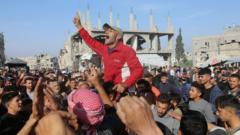
Shifting Sands: Gazan Residents Increasingly Vocal Against Hamas
For years, the narrative surrounding the Gaza Strip has often been dominated by accounts of external conflict and the entrenched power of Hamas. However, recent developments suggest a subtle but potentially significant shift in the internal dynamics of the region: a growing willingness among Gazan civilians to openly criticize Hamas, both on the streets and through online platforms.
A Climate of Fear? Examining the Historical Context
Historically, the environment within Gaza has been characterized by a palpable tension, stemming from the long-standing conflict with Israel and the internal governance of Hamas. Allegations of suppression of dissent, limitations on freedom of expression, and a tightly controlled information landscape have contributed to a perception of fear, discouraging public criticism of the ruling authority. However, a confluence of factors appears to be eroding this long-held reticence.
Cracks in the Facade: Indicators of Growing Discontent
Several indicators point towards an increasing level of open dissatisfaction within Gaza:
- Street-Level Conversations: Anecdotal evidence suggests a rise in public grumbling and direct criticism of Hamas's policies, particularly concerning economic hardship and the ongoing blockade. While previously such conversations would have been confined to private spaces, they are now reportedly occurring with greater frequency in public areas.
- Online Expression: The anonymity afforded by the internet has emboldened some Gazans to express their opinions more freely on social media platforms. While censorship and surveillance remain concerns, individuals are increasingly using pseudonyms and encrypted channels to voice their frustrations.
- Localized Protests: While large-scale organized demonstrations remain rare, smaller, localized protests addressing specific grievances, such as power shortages or unemployment, have become more visible. These demonstrations, though often swiftly dispersed, signal a growing willingness to challenge the status quo.
Driving Forces: Understanding the Underlying Causes
Several factors are likely contributing to this evolving dynamic:
- Economic Hardship: The prolonged blockade and intermittent conflicts have severely impacted the Gazan economy, leading to widespread poverty, unemployment, and a sense of desperation. This economic strain has fueled resentment towards Hamas, which is often perceived as failing to adequately address the population's basic needs.
- Disillusionment with the Status Quo: Years of unresolved conflict and a lack of tangible progress towards a peaceful resolution have left many Gazans feeling disillusioned with the current political landscape. This disillusionment extends to Hamas, which is increasingly seen as prioritizing its own political survival over the well-being of the population.
- Increased Access to Information: Despite restrictions, Gazans have increasingly access to information via satellite television, the internet, and social media, exposing them to alternative perspectives and narratives. This increased exposure to diverse viewpoints has challenged the dominant Hamas narrative and fostered a more critical outlook.
- Generational Shift: A younger generation, less encumbered by the historical context and more connected to the outside world, is emerging in Gaza. This generation is often more vocal in its demands for change and less willing to accept the status quo.
Potential Implications: What Does This Mean for the Future?
The growing open criticism of Hamas within Gaza has potentially significant implications for the future of the region. While it is unlikely to lead to an immediate overthrow of the organization, it could:
- Force Hamas to Adapt: Facing increasing internal pressure, Hamas may be compelled to adopt more conciliatory policies, improve governance, and address the population's pressing economic needs.
- Create Space for Alternative Voices: The erosion of fear could create space for alternative political actors and civil society organizations to emerge, challenging Hamas's monopoly on power.
- Influence Regional Dynamics: A more vocal and assertive Gazan population could influence the broader regional dynamics, potentially impacting the Israeli-Palestinian conflict and the relationship between Hamas and other Palestinian factions.
Challenges and Caveats: A Note of Caution
It is important to note that this shift is still in its early stages and faces significant challenges. Hamas maintains a strong security apparatus and is likely to respond forcefully to any perceived threat to its authority. The ongoing conflict with Israel and the blockade continue to create a difficult and unpredictable environment. Furthermore, expressing dissent remains risky, and many Gazans are still hesitant to openly criticize Hamas for fear of reprisal. Therefore, any assessment of this trend must be approached with caution and a nuanced understanding of the complex realities on the ground.
Ultimately, the long-term impact of this growing dissent remains uncertain. However, it represents a potentially significant development in the internal dynamics of Gaza, one that warrants close attention and careful analysis.
```